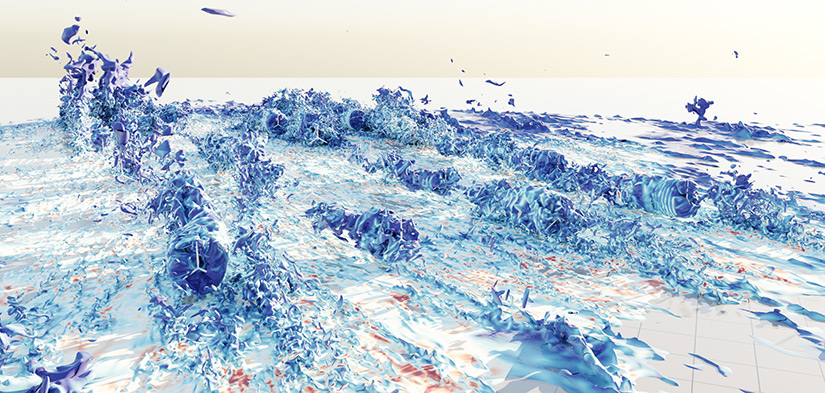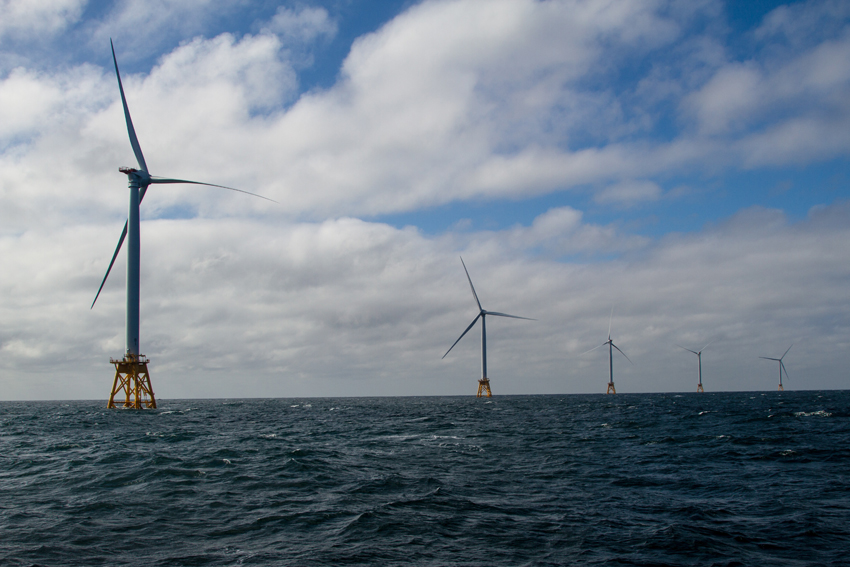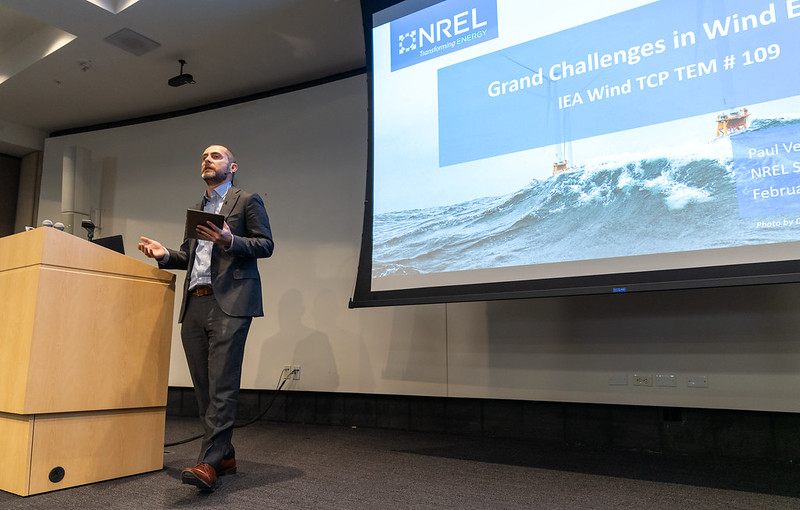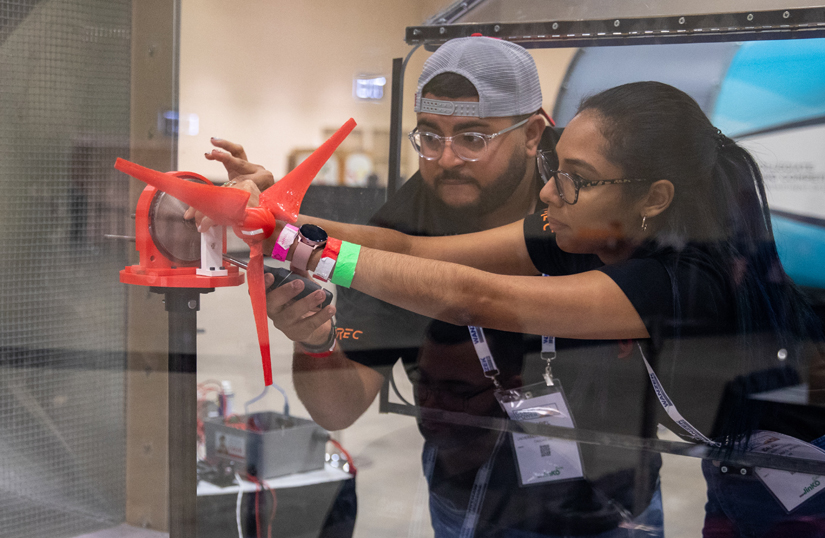The Leading Edge: April 2023 Wind Energy Newsletter
In this edition, we discuss improving wind turbine design, wave to a researcher across the ocean, and share updates on transmission and grid projects, news, and events.
News Stories
NREL, GE Research Team Finds Critical Adjustments To Improve Wind Turbine Design
Low-level jet streams, also known as low-level jets, behave in powerful and complex ways that can impact numerous American lives and livelihoods. Winds that blow along the U.S. coastline hit the homes of more than 128 million people; that same wind energy has the potential to bring ashore a gust of clean, renewable electricity to power these homes for decades to come.
To harness this renewable energy resource, states along the Atlantic Coast have pledged to deploy almost 20 GW of wind energy by 2035, which will make wind a substantial source of energy for the nation's most densely populated region. But understanding how low-level jets behave can unlock their full potential, and studying this invisible force has proved challenging for most researchers—until now.
With joint support from the National Offshore Wind Research and Development Consortium and GE Offshore Wind, researchers at the GE Global Research Center and the National Renewable Energy Laboratory (NREL) are studying the impact of low-level jet behavior along the Atlantic Coast on coastal wind farm installations to find critical insights for a burgeoning U.S. wind energy economy.

Behind the Blades
A Reliability Researcher Expands NREL's Connections From Her "Dream Job"
Yi Guo came from a family whose members all worked in or with the coal mining industry. She grew up wanting to leave a positive impact on society and the environment by working in the renewable energy sector.
"I hope for greater wind energy penetration in the future, with a goal of 100% environmentally friendly energy generation for the United States," she said.
Impatiently, she waited 2 years for an open position to pop up on NREL's careers site while finishing up her graduate degree at The Ohio State University. When it did, Guo jumped at the chance to join the lab and contribute to its mission to transform energy. In September 2011, she finally landed her dream job at "the leading research institute for renewable energy," as Guo called the lab.
For 11 years, she was part of the NREL wind energy team. Guo focused primarily on improving the reliability of wind turbine mechanical components, working to ensure they don't fail early on in their life, coordinating experiments, performing analyses, running models, and monitoring turbines on the lab's Flatirons Campus.
To be successful in those endeavors, she relied on teamwork. Collaborating with peers at the lab as well as in academia and industry, Guo calls her time at NREL "so valuable" for building up her career. She enjoyed hearing about needs and wants directly from members of the wind energy industry and then using her skills, together with her team, to solve their problems.
NREL enabled her to work with "wonderful people (some are legendary)," she said, involving "many collaborations with industry and academia, diversified skill sets if interested, and training and growth opportunities." Heading to Technical University of Denmark's Wind and Energy Systems, she'll be taking those networks and connections with her—and broadening NREL's, too.
"I absolutely love the wonderful people at NREL," Guo said. "We are a family here, and we take care of each other. I had many fun moments here at NREL. They will stay in my memory."

On the Radar
How Sea Surface Temperatures Affect Wind Resource Forecasting

Accurate wind resource forecasting can help offshore wind energy expand. However, many factors can affect how wind moves over the ocean, making forecasting tricky. One important yet relatively unexplored aspect of offshore wind resource assessment is the role of sea surface temperature. In a new article published in Wind Energy Science, NREL wind energy researchers found that, compared with observations, significant variations that occur on finer timescales (such as sea breezes and low-level jets) may not be correctly represented in model results. To forecast these variations better, models should use finer (hourly, at least) resolutions. This will help provide developers with a better understanding of local wind patterns to inform wind power plant planning and layout decisions.
Modeling Improves Floating Offshore Vertical-Axis Wind Turbines
Vertical-axis wind turbines could be advantageous for use in floating offshore wind applications, as several of their characteristics yield a lower levelized cost of energy than their horizontal-axis counterparts. In a new article published in Energies, NREL wind energy researchers and colleagues at Sandia National Laboratories emphasize that verified and validated design tools are needed to optimize and reduce the costs of floating offshore vertical-axis wind turbines. The article describes how, by coupling the HydroDyn and MoorDyn modules in NREL's OpenFAST tool with Sandia's Offshore Wind Energy Simulator, researchers can now model a floating substructure as a rigid body with hydrodynamics and mooring dynamics, thereby enabling studies of the dynamics of the coupled turbine-platform system. This effort helps facilitate the continued development of the Offshore Wind ENergy Simulator by introducing and validating additional capabilities for floating vertical-axis wind turbine applications, thus enabling widespread deployment.
Downwind: In Case You Missed It
NREL Hosts Grand Challenges in the Science of Wind Energy Topical Expert Meeting
More than 100 wind energy experts from 15 countries attended an International Energy Agency Wind Technology Collaboration Programme Topical Expert Meeting, hosted at NREL in late February 2023, to revisit the grand challenges in wind energy science. Organized by NREL, the meeting sought to create a better understanding of how the social and environmental impacts of wind energy should be integrated into future studies on the grand challenges of wind research. Specifically, these challenges include the atmosphere, the wind turbine, and the plant and grid. Meeting outcomes, to be published soon, will provide a road map for researchers at NREL—and around the world—to ensure wind energy projects over the next 5 years consider the social and environmental impacts of increased wind energy deployment.

Tenth Annual Collegiate Wind Competition Will Breeze Into Boulder, Colorado, This May
Come meet the next generation of wind energy professionals. The 10th annual U.S. Department of Energy Collegiate Wind Competition final event will take place at the University of Colorado Boulder's Balch Fieldhouse May 15–19, 2023.

Throughout the week, 13 teams of college students will test their prototype wind turbines, present their work to a panel of wind industry experts, network with wind industry professionals, and more. The Collegiate Wind Competition helps college students prepare for jobs in the wind and renewable energy workforce through real-world experiences with wind energy technology, project development, finance, communications, and outreach. Register to attend the 2023 final event, and find out how you can get involved in future competitions.
Upcoming Events and Opportunities
Join NREL and Wind Energy Technologies Office researchers at upcoming events. Below are a few highlights.
Collegiate Wind Competition 2023 Final Event
May 15–19, 2023, Boulder, Colorado
Register to attend any or all of the 10th annual U.S. Department of Energy Collegiate Wind Competition final event at the University of Colorado Boulder's Balch Fieldhouse in Boulder, Colorado, May 15–19, 2023.
Clean Energy to Communities Partnership Proposals Due
May 17, 2023, Online
The Clean Energy to Communities program is seeking four to five communities for in-depth technical partnerships that will help them address challenges to achieving their clean ambitions with help from NREL and other national labs. Submit a proposal by May 17, 2023.
NAWEA/WindTech 2023 Conference Abstracts Due
May 19, 2023, Online
The 2023 North American Wind Energy Academy (NAWEA)/WindTech Conference—which will be held in person Oct. 30–Nov. 1, 2023, near Boulder, Colorado—will focus on a future in which high levels of wind energy deployment meet the needs of a grid dominated by renewable energy. The conference will feature the latest research to integrate wind energy with solar power, energy storage, and other energy sources into the complex and highly interdependent energy system of the future. The event will also address the social and environmental issues at the core of such an expansion and include the "grand challenges" of wind energy. Subscribe to get conference updates.
Community Technical Assistance Applications Due
May 19, 2023, Online
The U.S. Department of Energy's Energy Transitions Initiative Partnership Project helps remote and island communities transform their energy systems and increase energy resilience, supported by NREL and other regional partners. Apply for assistance by May 19, 2023.
Wind Energy Science Conference 2023
May 23–26, 2023, Glasgow, United Kingdom
Join committee members, presenters, and session chairs from NREL at the biennial conference designed to bring together leading scientists and researchers in wind energy to discuss a range of topics related to the field.
Rural Communities Energy Prize Applications Due
May 24, 2023, Online
Challenges from the U.S. Department of Energy's American-Made program offers renewable energy prizes open to everyone, including the Emerging Rural Communities Prize (applications due May 24, 2023).
NREL in the News
Emerging Trend: Wind Turbines Paired With Energy Storage, Ivan Mednikov and Ivor Shaw, Windpower Engineering & Development, April 17, 2023
Researchers Modeling Jet Stream Interference With Offshore Wind, John Cropley, RTO Insider, April 16, 2023
It's Time for Virginia To Plan Its Next Offshore Wind Farm, Ivy Main, Virginia Mercury, April 10, 2023
Mexican Potential in Wind Energy, Reve, April 9, 2023
DOE Announces Efforts To Address Transmission Development For West Coast Offshore Wind, Stephen J. Hug, Ben N. Reiter, and Emily P. Mallen, Akin, April 6, 2023
Nine U.S. Floating Wind Foundation Projects Win USD 1.6 Million From Department of Energy, Adrijana Buljan, OffshoreWIND.biz, March 30, 2023
Missouri Saw Small Gains In Wind, Solar Energy Capacity Last Year, Robert Zullo, Missouri Independent, March 30, 2023
Entergy, RWE Partner To Assess Offshore Wind Prospects in Gulf of Mexico, Sonal Patel, Power, March 30, 2023
Bangladesh Identifying Prime Spots for Offshore Wind, Adnan Durakovic, OffshoreWIND.biz, March 30, 2023
Offshore Wind Industry Power Players Headline 2023 International Offshore Wind Partnering Forum, Business Network for Offshore Wind, March 29, 2023
Publications
Analysis
A Three-Dimensional, Analytical Wind Turbine Wake Model: Flow Acceleration, Empirical Correlations, and Continuity, Renewable Energy (2023)
Effects of Wind Field Characteristics on Pitch Bearing Reliability: A Case Study of 5 MW Reference Wind Turbine at Onshore and Offshore Sites, Forschung im Ingenieurwesen (2023)
Great Lakes Wind Energy Challenges and Opportunities Assessment, NREL Technical Report (2023)
Offshore Wind Energy Forecasting Sensitivity to Sea Surface Temperature Input in the Mid-Atlantic, Wind Energy Science (2023)
Software and Tools
Addressing Deep Array Effects and Impacts to Wake Steering With the Cumulative-Curl Wake Model, Wind Energy Science (2023)
Comparison of Free Vortex Wake and Blade Element Momentum Results Against Large-Eddy Simulation Results for Highly Flexible Turbines Under Challenging Inflow Conditions, Wind Energy Science (2023)
Dynamic Modeling of Slip in a Wind Turbine Spherical Roller Main Bearing, Forschung im Ingenieurwesen (2023)
Enabling Floating Offshore Vertical Axis Wind Turbine Design by Coupling Offshore Wind Energy Simulator and OpenFAST, Energies (2023)
Using Observational Mean-Flow Data to Drive Large-Eddy Simulations of a Diurnal Cycle at the SWiFT Site, Wind Energy (2023)
Technology
Infusible Thermoplastic Composites for Wind Turbine Blade Manufacturing: Fatigue Life of Thermoplastic Laminates Under Ambient and Low-Temperature Conditions, Advanced Engineering Materials (2023)
Want More?
Subscribe to The Leading Edge newsletter, and explore the latest news and accomplishments in wind energy at NREL.
Share

